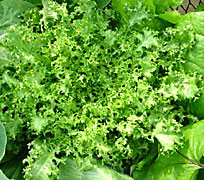


Home
Flowers &
Indoor Plants
Fruits & Nuts
Ornamentals
Vegetables
Special Topics
Resources
Glossary

|
Endive Cichorium endiva (sick-or-ee-um en-di-va)  Click on thumbnails for larger image. |
 |
What about it? Endive is in the sunflower family and is related to chicory, lettuce, and radicchio. Endive grows as a loose head or rosette of leaves which are extremely curled and serrated. Escarole, a type of endive, has flat broad leaves that are less cut at the margins. What is it used for? Used alone, endive is somewhat bitter, but when mixed with other greens, it adds tang to the flavor of salads. Where does it grow? How do we grow it?Endive should be planted 1/4 to 1/2 inches deep in rows that are spaced 8 to 12 inches apart as soon as the ground can be worked. Endive will grow in the summer, but may become so acrid they are inedible. The leaves should be drawn up and tied at the top to form a temporary closed head for about 10 days. This blanches the inner leaves and reduces the bitter taste formed in response to light and heat. What are its primary problems? Insects commonly found on endive plants include aphids, flea beetles, leafhoppers, leaf miners, and loopers. Common diseases of the endive plant include aster yellows, big vein, and bottom rot. How do we harvest and store it? Endive is normally ready to harvest 75 to 90 days after it is planted. If left longer in the garden,the plant may brown and become diseased. Endive plants should be harvested when they reach 6 to 14 inches, depending on the variety. When harvesting, cut the heads with a sharp knife at the very base of the plant and even a little below the soil line. Leaves must be lifted to reach the base of the endive. Once the plant is cut free, discard leaves that are off-color or have holes. Soon after it is harvested, endive must be kept in a refrigerator. The leafy plants lose water rapidly and should be put in a plastic bag after washing and draining.
© Copyright, Department of Horticulture, Cornell University. |